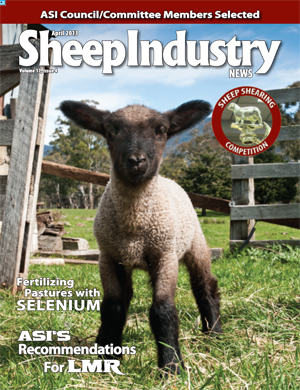
- April 2013
- Elite Sheep Shearers Compete at Stock Show
- USDA Releases Sheep 2011 Part II Report: Marketing and Death Loss
- ASI’s Recommendations for Mandatory Price Reporting
- 2013 ASI Council and Committee Members
- H-2A Working Group Meets to Discuss Program
- Fertilizing Pastures with Selenium, Best Way to get It to Livestock
- News from the Resource Council
- Installation Highlights Beauty of Wool
- Western Section of the American Society of Animal Science (WSASAS) Sheep Symposium
ASI’s Recommendations for Mandatory Price Reporting
(April 1, 2013) In March, the American Sheep Industry Association relayed its top priorities to update Livestock Mandatory Reporting (LMR) to the U.S. Department of Agriculture’s Agricultural Marketing Service (AMS) based on a report from the Livestock Marketing Information Center titled, “Analysis of Mandatory Price Reporting System for Lamb.” Since LMR became effective nearly 12 years ago, structural changes in the industry threaten the sustainability of timely market information primarily due to the application of the 3/70/20 guideline.
The letter states, “After a decade, it has become apparent that the availability and use of LMR data has changed along with the changes that have occurred in our industry. Therefore, we believe it is time to carefully consider LMR lamb reporting and make the changes necessary to ensure that high-value and usable market data are collected and reported to better reflect the present state of the industry.”
ASI believes these recommendations should help to alleviate many of the current problems with meeting the 3/70/20 for lamb. The ones that stand out and are of high priority for the industry include:
- Reduce the packer/processor reporting threshold to at least 35,000 head per year for each of the past two years. Changing the reporting threshold number and time window will better-reflect slaughter lamb supplies and account for the dynamic nature of business decisions in the packer/processing sector.
- Reduce the importer threshold to at least 1,500 metric tons per year for the past two years. Changing the reporting threshold and time window would be more consistent with the above for domestic packer/processor recommendations and better-reflect current business practices in a rapidly changing trade environment.
Add a pelt price category under LMR that reflects the value paid by packers to producers for slaughter lambs purchased on a negotiated, formula or contract basis. - Review, update and/or redefine the “custom processing” definition currently used under LMR for lamb reporting so that lamb prices can be reported for this large and growing lamb marketing sector. In excess of 25 percent of the annual number of U.S. lambs currently marketed fall under the current AMS “custom processing” category thus, the volume and prices paid for these lambs are not captured in the weekly LMR reports.
- Update the calculations used to determine the Estimated National Lamb Carcass Cutout report, including the net carcass value costs, and review these calculations every two years to help keep this series current with industry conditions.
- Evaluate the imported cut item categories that are currently and in recent history sold in the U.S. market and adjust categories either by eliminating unnecessary items and/or grouping similar items into more general categories as appropriate to provide for more imported product data reported. Likewise, domestic wholesale cut categories should be evaluated and adjusted to reflect recent and current marketing practices.
- Evaluate and adjust for lamb reporting, the LMR definitions for “forward contract” and “forward priced” to reflect recent and current lamb marketing practices and reconsider a “lambs committed” category that would capture transactions for lambs that will be processed in the future.
- Require LMR participants to submit data in the required format and enforce approved detailed reporting.
The letter concluded by stating, “We urge AMS to carefully consider and address these recommendations as soon as possible whether by proposed rulemaking where required or by adjusting forms or categories when possible (for example adding an 85-95 lb. and over 95 lb. category to the carcass reports) and enhanced enforcement of the reporting requirements.”

